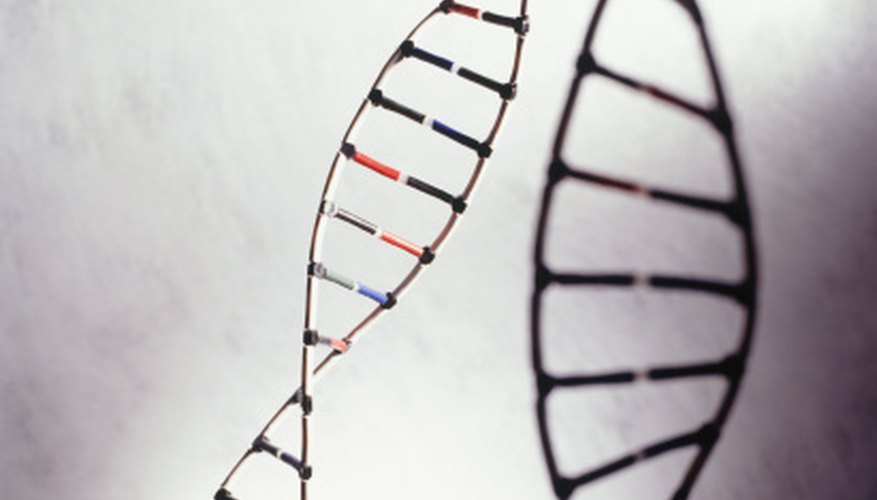Popsicle sticks can be a useful tool for creating a visual display of DNA in a double-helix form. The double-helix structure takes the shape of a ladder that winds around itself repeatedly. In the Popsicle stick model, the outer Popsicle sticks represent the deoxyribose (sugar) and phosphate groups that alternate to create the backbone of the structure. The inner Popsicle sticks are used to represent the nucleotides cysteine, thymine, adenine and guanine. Each set of Popsicle sticks represents one type of nucleotide.
Paint each Popsicle stick based on what it represents. Paint 12 Popsicle sticks black to represent the deoxyribose and phosphate structure. Paint three Popsicle sticks green, three red, three yellow and three blue to represent the nucleotides. Paint both sides of each Popsicle stick, and let the painted Popsicle sticks dry completely before proceeding.
- Popsicle sticks can be a useful tool for creating a visual display of DNA in a double-helix form.
- Paint 12 Popsicle sticks black to represent the deoxyribose and phosphate structure.
Glue the black Popsicle sticks together to form the sugar and phosphate backbone structure. Use six black Popsicle sticks and glue them end to end to form a long line. Do the same with the remaining six black Popsicle sticks.
- Glue the black Popsicle sticks together to form the sugar and phosphate backbone structure.
- Do the same with the remaining six black Popsicle sticks.
Label the coloured Popsicle sticks representing the nucleotides. Using a marker, label both the top and bottom tip of each Popsicle stick with a letter corresponding to the appropriate nucleotide. For example, label the top and bottom tip of each red Popsicle stick with a "C" for cysteine; label the tips of each green Popsicle stick with a "T" for thymine; label the tips of each blue Popsicle stick with an "A" for adenine; and label the tips of each yellow Popsicle stick with a "G" for guanine.
Cut each of the coloured Popsicle sticks in half. You should be able to see the label marker on the tip of each Popsicle stick half.
Glue all the "adenine" Popsicle stick halves to all the "thymine" Popsicle stick halves. The nucleotides adenine and thymine always pair together in a DNA structure.
Glue all the "guanine" Popsicle stick halves to all the "cysteine" Popsicle stick halves. These nucleotides always bond together in a DNA structure.
- Glue all the "adenine" Popsicle stick halves to all the "thymine" Popsicle stick halves.
- Glue all the "guanine" Popsicle stick halves to all the "cysteine" Popsicle stick halves.
Position the two sets of black Popsicle sticks on a flat surface. The black Popsicle sticks will form the structure of the model. Set up the black Popsicle stick structures in a parallel line close enough together to glue the coloured Popsicle sticks on top.
Lay the coloured Popsicle stick pairs on top of, and perpendicular to, the black structures, creating a ladder shape. Alternate the cysteine-guanine pairs with the adenine-thymine pairs. Evenly space the coloured Popsicle stick pairs. When you have the structure set up as appropriate, glue the tips of each coloured Popsicle stick pair to the edge of the black Popsicle stick structure.
Flip the entire structure over once the glue has dried to reveal a ladder shape that hides the tips of the coloured Popsicle sticks.
TIP
Try creating a DNA model with other materials. Construction paper, pipe cleaners and painted foam spheres all make good DNA model material.
